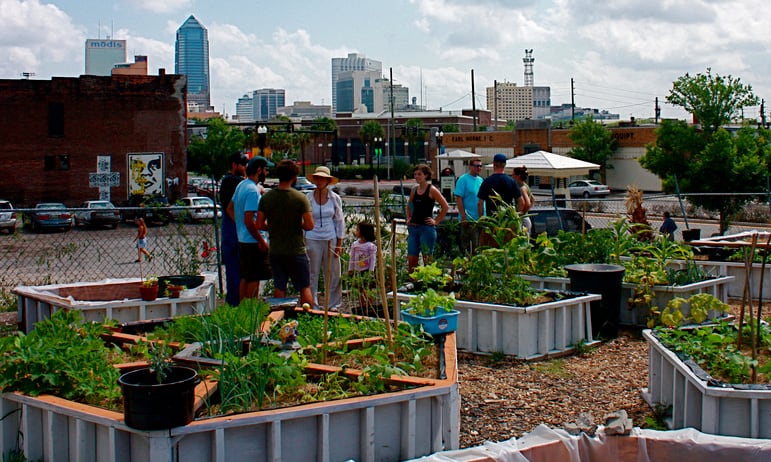The Main Principles Of City Blooming
The Main Principles Of City Blooming
Blog Article
A Biased View of City Blooming
Table of Contents9 Easy Facts About City Blooming ExplainedThe 10-Second Trick For City BloomingSome Known Details About City Blooming What Does City Blooming Do?The Only Guide for City Blooming
Interested in expanding food for sale in the City of Chicago? Thinking of starting a community garden? Adjustments to the Chicago Zoning Ordinance enable farming uses like area gardens and metropolitan ranches in several parts of the city. Below is a list of often asked questions pertaining to the policies and regulations that farmers should consider when planning an urban agriculture project.
The zoning amendment does not customize any various other codes managing composting, structure licenses, buying or renting City owned residential property, business licenses or ecological contamination. There are existing codes that control these issues and they stay completely result and might apply to your job. Neighborhood yards are commonly owned or taken care of by public entities, public organizations or community-based organizations and maintained by volunteers.
Urban ranches grow food that is meant to be marketed, either on a not-for-profit or for-profit basis. Due to their industrial function, urban ranches require an organization license.
Indicators on City Blooming You Should Know
The quantity of compost product can not go beyond 25 cubic backyards at any type of offered time according to the requirements in 7-28-715 of the City's Municipal Code. Since the dirt at most new garden sites needs changing, garden compost, dirt, timber chips, or other products can be obtained to construct or improve the expanding area.

If a building permit is needed then the hoophouse will certainly be taken into consideration an accessory structure. You can learn even more regarding the building authorization demands by contacting the Department of Buildings. The 25,000-square-foot dimension limitation is intended to protect against a solitary neighborhood yard from dominating a provided block or diminishing the block's existing domestic or industrial character.
The limitation does not use to gardens found in Public Open Area (POS) areas. Can there be more than one neighborhood garden that is 25,000 square feet on a solitary block? Fencing is not required, nonetheless, yards that have large car parking areas might be called for to set up fencing or other landscape design features.
Everything about City Blooming
B1 & B2 districts need that all industrial usage tasks be performed inside your home. R districts limit business task. The regulations show the function and intent of the Zoning Code. Is secure fencing needed for urban farms? Yes. Fencings may be needed, in addition to landscape design and testing, for sure auto parking areas and exterior job or storage locations depending on area and the specific activity taking place.
Yes. Urban ranches require structure licenses and zoning authorizations before building. Various other types of city testimonial may be required depending on certain frameworks, activities, size, landscape design, licensing, public heath and stormwater administration issues. Much of these needs are identified in the task layout or allowing process, however, the applicant may be accountable to independently recognize specific licenses or permits that might be required.
Yes. The kind of license is figured out by what is taking place at the site. The Division of Organization Matters and Customer Security can help figure out the certain kind of service certificate that's called for. Yes. Off street car park is needed for most business projects in Chicago. The needed number of car park rooms is based upon the variety of workers working on site and not the square footage of the expanding space.
Everything about City Blooming

Yes. A city farm can sell garden compost product produced on website, however, the procedure needs to follow the laws in 7-28-715 of the Chicago Municipal Code. Yes. Aquaponic systems are permitted inside your home on urban ranches in numerous zoning districts. A zoning evaluation and building license is called for in order to set up structures or systems and a service certificate is required as described above.
Approximately five hives or nests of honey bees might be kept as an accessory usage. However, beekeepers should register with the Illinois Department of Farming. For additional information about the recommended zoning change you might get in touch with the Department of Real Estate and Economic Growth, Bureau of Preparation and Zoning at 312.744.8563.
Farming in cities and city locations An urban ranch in Chicago. Urban agriculture describes numerous practices of cultivating. https://www.brownbook.net/business/52834376/city-blooming/, handling, and dispersing food in urban locations. The term additionally puts on the area activities of pet husbandry, aquaculture, beekeeping, and horticulture in a metropolitan context. Urban agriculture is distinguished from peri-urban farming, which happens in backwoods at the edge of suburban areas.
City Blooming Things To Know Before You Get This
, that seek to form social networks started on a common values of nature and community holism. These networks pop over to this site can create by method of official institutional assistance, coming to be incorporated right into neighborhood town planning as a "transition community" motion for sustainable urban development.
Some of the initial proof of city agriculture comes from Mesopotamia.
Report this page